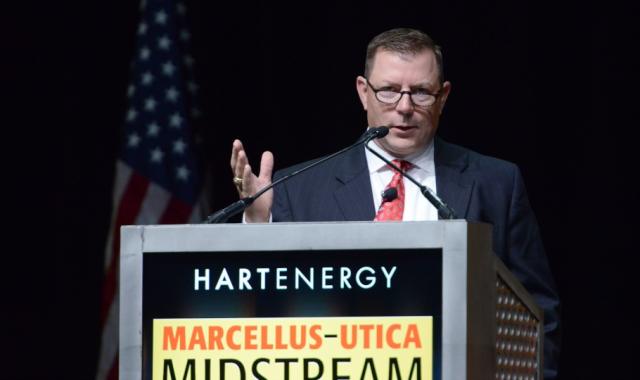
Harry W. New, president of Houston-based Willbros Oil & Gas, speaks at the Marcellus-Utica Conference in Pittsburgh. Source: Hart Energy
PITTSBURGH—There are 13 major projects currently planned for the Marcellus region, representing more than 3,330 miles of pipe and roughly $28.4 billion of capex. Ten are scheduled for this year and the other three in 2018.
A bulk of that gas from those projects is headed to existing LNG facilities, plants planned primarily on the Gulf Coast, some on the East Coast and even Mexico.
However, will the staggering amount of projects in the works actually be completed? Harry W. New, president of Houston-based Willbros Oil & Gas, believes it will be a challenging feat to execute.
“Based on my calculations, you’re looking at roughly 84 construction spreads to execute all that work. If you look at our market today—go through the contractors and what their capabilities are, what their capacity is—I thinks it’s going to be a very difficult task to pull off,” New told attendees at Hart Energy’s 2017 Marcellus-Utica Midstream Conference & Exhibition in January. And that doesn’t even count the spreads needed for other projects closer to the Gulf Coast and the Permian Basin, he said.
“I think that stretches the contractor’s capacity even further, so it’s definitely going to be a lot of undertaking to get all that done,” New said.
Additionally, New discussed the impact of public opposition on projects, leading him to believe more protesters will continue to migrate to the Marcellus as a result of all the activity planned, including the Keystone XL Pipeline and the Dakota Access Pipeline. Other impacts include schedules not being met with FERC and not receiving permits when expected, and also state agencies leaving projects on the shelf.
How does that affect the contractor?
“That points to the financial hardship,” New said. “When you keep getting a project denied, at some point the client will at times dismantle the project, and we’ve seen that happen as well, so there’s definitely financial impacts involved.”
Project delays could also cause contractors to lose their capabilities and availability, he said, as it becomes harder to execute and expensive to maintain talent without work. New said one of the biggest challenges is how to work around that.
To work through these challenges, New said contractors need to start with a well-defined scope. “The better scope we have on a project, the better we can access the price of the project, minimize risk and lessen the contingency required to perform the execution of the project,” he said.
Second, emphasize a culture of safety. “Without a great safety record, a lot of times you may not get to bid because you don’t meet the clients’ safety requirements. So that’s something that we demand to have, that safety culture with our people,” New said.
He also noted that getting involved early with a client on a project can help with permitting and executing certain pieces of the project.
“I think the talent that we possess at Willbros, we definitely have an advantage of helping the client on tough issues, tough areas … minimize some of the impacts out in the field and help them get their permits,” he said. “Our goal is to support United States infrastructure.”
Brandy Fidler can be reached at bfidler@hartenergy.com.
Recommended Reading
Sintana Reports Two Discoveries Offshore Namibia
2025-01-02 - Sintana Energy Inc. said the Mopane-2A well found gas condensate in one reservoir and light oil in a smaller one.
Innovative Insulation: The Future of Thermal Management
2024-12-31 - Silicone-based, spray-on coating simplifies application and improves protection for downstream assets and workers.
E&P Highlights: Dec. 30, 2024
2024-12-30 - Here’s a roundup of the latest E&P headlines, including a substantial decline in methane emissions from the Permian Basin and progress toward a final investment decision on Energy Transfer’s Lake Charles LNG project.
Subsea7 Awarded Contract for Gas Field Offshore Turkey
2024-12-30 - Subsea7 will provide inspection, repair and maintenance for the Sakarya field.
Delivering Dividends Through Digital Technology
2024-12-30 - Increasing automation is creating a step change across the oil and gas life cycle.
Comments
Add new comment
This conversation is moderated according to Hart Energy community rules. Please read the rules before joining the discussion. If you’re experiencing any technical problems, please contact our customer care team.






